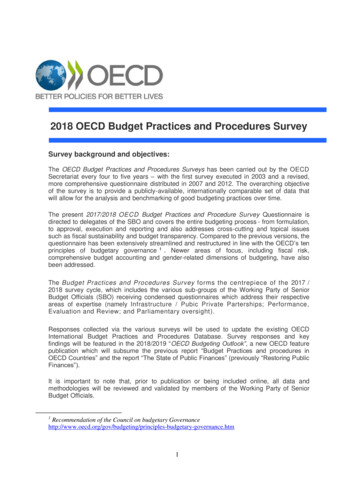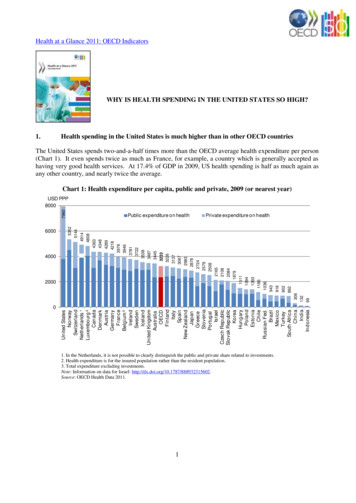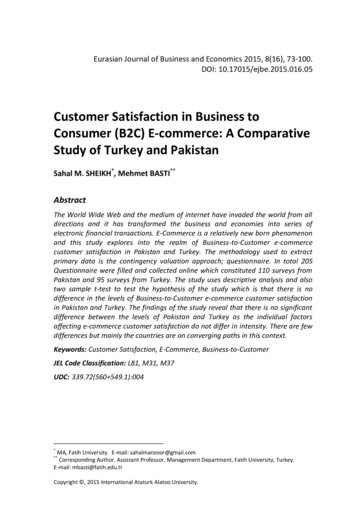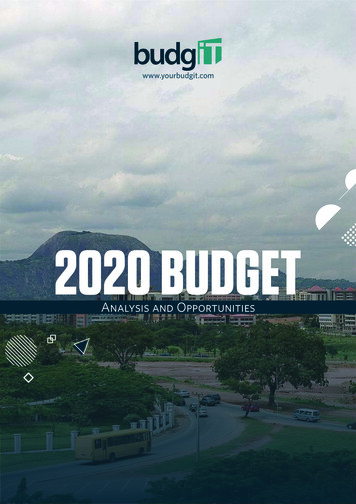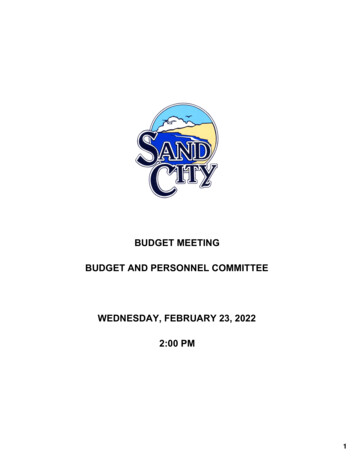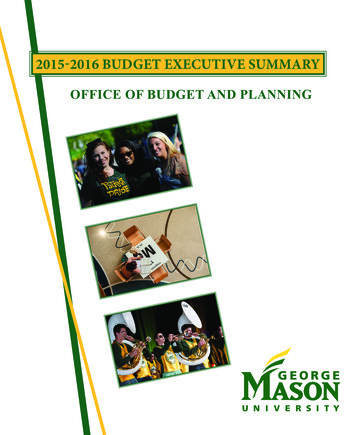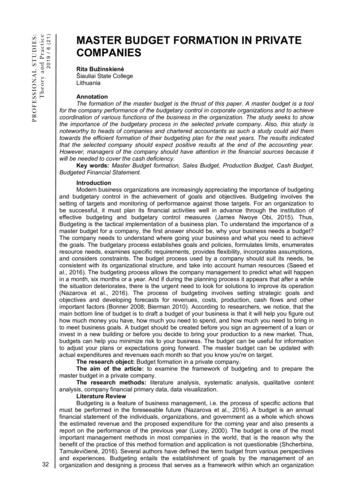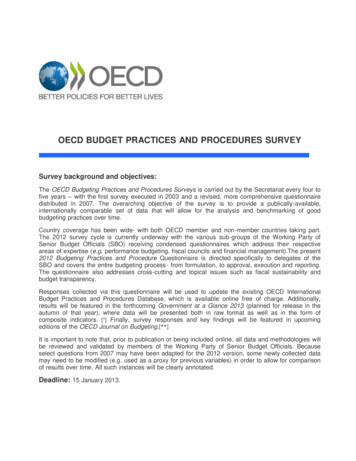
Transcription
OECD BUDGET PRACTICES AND PROCEDURES SURVEYSurvey background and objectives:The OECD Budgeting Practices and Procedures Surveys is carried out by the Secretariat every four tofive years – with the first survey executed in 2003 and a revised, more comprehensive questionnairedistributed in 2007. The overarching objective of the survey is to provide a publically-available,internationally comparable set of data that will allow for the analysis and benchmarking of goodbudgeting practices over time.Country coverage has been wide- with both OECD member and non-member countries taking part.The 2012 survey cycle is currently underway with the various sub-groups of the Working Party ofSenior Budget Officials (SBO) receiving condensed questionnaires which address their respectiveareas of expertise (e.g. performance budgeting, fiscal councils and financial management).The present2012 Budgeting Practices and Procedure Questionnaire is directed specifically to delegates of theSBO and covers the entire budgeting process - from formulation, to approval, execution and reporting.The questionnaire also addresses cross-cutting and topical issues such as fiscal sustainability andbudget transparency.Responses collected via this questionnaire will be used to update the existing OECD InternationalBudget Practices and Procedures Database, which is available online free of charge. Additionally,results will be featured in the forthcoming Government at a Glance 2013 (planned for release in theautumn of that year), where data will be presented both in raw format as well as in the form ofcomposite indicators. [*] Finally, survey responses and key findings will be featured in upcomingeditions of the OECD Journal on Budgeting.[**]It is important to note that, prior to publication or being included online, all data and methodologies willbe reviewed and validated by members of the Working Party of Senior Budget Officials. Becauseselect questions from 2007 may have been adapted for the 2012 version, some newly collected datamay need to be modified (e.g. used as a proxy for previous variables) in order to allow for comparisonof results over time. All such instances will be clearly annotated.Deadline: 15 January 2013.
Action:Please note that the document attached to the e-mail invitation sent to the respondent is only intendedfor reference, to help planning your responses and coordinate with colleagues/other respondents. Finalresponses must be submitted via the online questionnaire. The use of the online instrument will helpimprove data quality and comparability.Via email, the Secretariat will provide delegates to the SBO with a web link to the questionnaire, aswell as the corresponding username and password needed to access it. The online questionnaire toolallows respondents to start and stop the questionnaire at their convenience (answers will be saved),and to share the responsibility of responding with other officials/experts. Further technical instructionswill also be provided by email.Delegates are asked to kindly nominate a respondent(s), coordinate with the respondent(s) to finaliseanswers, and liaise between the OECD and the respondent(s) after final submission should any furtherclarification or verification be needed. SBO Delegates however are responsible for the validation andaccuracy of the final submission of data.Prior to and during completion, respondents are encouraged to consult their previous years’ responsesfrom their governments at:http://www.oecd.org/document/61/0,3746,en 2649 34119 2494461 1 1 1 1,00.htmlHelp:For further assistance, information or advice in completing this questionnaire please contact KnutKlepsvik (Knut.Klepsvik@oecd.org) and/or Natalia Nolan Flecha (Natalia.nolanflecha@oecd.org). If arespondent encounters questions which they find very difficult or resource-intensive to answer, theyshould not hesitate to contact the Secretariat for assistance.[*] Government at a Glance: www.oecd.org/gov/indicators/govataglance[**] OECD Journal on Budgeting:http://www.oecd.org/document/0,3746,en 2649 34119 2074062 1 1 1 1,00.html
Important guidelines for completing the questionnaire:Respondents of questionnaireAs previously mentioned, delegates to the SBO are asked to nominate a respondent or group ofrespondents that they deem qualified to answer the enclosed questions. These should be firstly fromthe Central Budget Authority (CBA) and specifically, from a Division/Unit responsible in the Executiveresponsible for budget formulation and oversight. If these responsibilities are shared by differentDivisions/Units within or outside of the CBA, stakeholders from all applicable institutions should beinvolved in responding to the questionnaire. In such cases, SBO delegates are kindly asked to facilitatethis process and take ownership/responsibility for the accuracy of the final submission.Scope of questionnaireWith very few exceptions (which are clearly indicated), respondents are asked to provide information ordata on the policies and practices in place in central/federal government (these terms are consideredsynonymous and are hereafter referred to as central government). While this limits the scope of theresponses and will not capture the activities of sub-national governments (which account for a largeproportion of expenditures within many countries), it ensures that the data are comparable across allresponding countries.Definitions of key termsWhen completing this questionnaire, kindly review and actively refer to the Glossary of Key Terms(here attached; the link will also be provided on the first response page of each section of thequestionnaire). In the majority of instances, OECD definitions have been applied as published in theOECD Journal on Budgeting.It is possible that the terminology applied in this questionnaire may not exactly match- or may not beapplicable- to the particular context in your country. In such cases, please use the comments section(or other space provided) to specify the terminology used in your country and clarify your choice ofresponse. This additional clarification will enhance comparability and data quality.Data availabilitySeveral questions in the questionnaire will ask countries to provide quantitative data. If this data is notavailable, if it is being provided for a time period other that what is asked in the question, or if thereare important caveats that should be known, please be sure to note these in the comments sectionprovided.
RESPONDENT(S’) CONTACT INFORMATIONContact: Please provide the contact information for the main person responsible for responding tothis questionnaire. This information will be used by the OECD in case follow-up is needed to clarifyresponses to enhance data comparability across countries. If you would like to list multiple contacts,you can enter the information for the additional staff at the end of this page.* Surname (s):* First Name (s):* Respondent’s institution (name and web link of Central Budget Authority, Line Ministry/Department or ExecutiveAgency under Line Ministry/Department):* Position/title:* Email address (summary of responses will be sent automatically to this address upon completion):* Telephone:Names and emails of additional respondents, if applicable:
Structure of Questionnaire:The questionnaire is organised into the following four parts:Part I - General informationPart II - Budget formulationII.1 - Macroeconomics estimates and fiscal projectionsII.2 - Fiscal rulesII.3 - Medium-term expenditures frameworkII.4 - Executive budget negotiationII.5 - Off-Budget expenditures (excluding PPPs)II.6 - Public-Private PartnershipsII.7 - Budget transparency and participationII.8 - Performance budgetingPart III - Budget approvalPart IV - Budget executionIV.1 - Expenditure flexibilityIV.2 - Supplementary budgetsIV.3 - Reserve funds
PART I - GENERAL INFORMATION* 1a. Where is the function of the Central Budget Authority (CBA) located in your government?Please select one.a. Ministry of Finance/Economyb. President’s Officec. Prime Minister’s Officed. Independent agencye. Other central government institutionf. CBA is split between two or more Ministries/Agencies, please specify organisations and provide web links toeach:Additional comments:Please use this space as needed to clarify your responses above.* 1b. If yes to 1a,b,c or e, please provide the formal name of the Central Budget Authority(CBA) organisation in your country along with a corresponding web link:* 2. Please indicate whether the head of the CBA is:Please select onea. A senior civil servant (e.g. a government official who ordinarily remains in this position when there is a change inGovernment.)b. A political appointee (e.g. a person who generally does not remain in this position when there is a change inGovernment).c. Other, please specify:
* 3. In practice, please indicate which of the below activities are responsibilities of the CBA.Select one column (i-iv) per row. If not applicable (e.g. activity not conducted/performed) you may indicate this asoption iv (if no "Other" option exists, please indicate "Not applicable").ii. Sharedi. Soleresponsibilityresponsibility between theof the CBACBA and otherinstitutionsiv. Notiii. Not aapplicable (e.g.responsibilityactivity notof the CBAperformed)If shared (ii), pleaseprovide name(s) ofother institution(s)involved, includingnon-governmentala. Drafting the Budget Circularb. Developing methodology/modelsfor macroeconomic projectionsc. Developing methodology/modelsfor fiscal projectionsd. Determining final budgetceilings/targets for line ministriese. Conducting negotiations with lineministries/agenciesf. Developing Executive BudgetProposalg. Testifying before Legislatureh. Authorisation of line ministries’outlaysi. Monitoring performance of lineministries/agenciesj. Producing supplemental budgetsk. Producing mid-year (or quarterly)reportsl. Producing end-of year reportsm. Communications (with public,media)n. Other key responsibility, pleasespecify:4. Please provide the number of full-time staff employed in the CBA, if possible, in terms of fulltime equivalents (FTE):Insert number of staff in thiscellTotal full-time staffIndicate whether the figure isa head-count or FTEHead countFTEComments (optional):
* 5. What, if any, is the legal basis for each of the following?For each row, please select all columns that apply.i. Stipulatedin theConstitutiona. The form and structure of theannual budget (e.g. theorganisation, form of itemisation,the types of supplementalinformation which must beincluded, etc.)b. The roles and responsibilitiesof the different parts of theExecutive in budget formulationand execution (e.g. division ofresponsibilities between CBA, LineMinistries and Presidents’/PMs’office in budget preparation andspending procedures)c. The roles and responsibilities ofthe Legislature and the Executivein the budget process (e.g.division of responsibilitiesbetween the Executive andLegislature in budget review,approval and spendingprocedures)d. Provisions for what happenswhen the budget is not approvedby the beginning of the fiscal yeare. Requirement for legislativeauthorisation of spendingf. Requirement for legislativeauthorisation of additional taxesand/or tax reformsg. Management and reportingrelating to off-budgetexpendituresh. Rules for the use ofcontingency or reserve fundsi. Requirements for internal auditstructures in line ministriesj. Requirement for audit ofGovernment accounts by theSupreme Audit Institutionii. Stipulated in iii. Stipulated iniv. Stipulated inlaw or policy regulation thatorganisationalthat requiresdo not requireor internalapproval byapproval byrulesthe LegislatureLegislaturev. NoformalbasisComments(especially if morethan one answerselected per row)
* 6.Generally speaking, what is the timeframe of the budget cycle?If date varies each year, please indicate generally whether it is the beginning, middle, or end of the month.Additionally, please indicate which milestones of the budget cycle are stipulated by law and/or official rules, andwhich are not.(i) Indicate thedate/month for thismilestone (month ismandatory while(ii) If date varies each year,date may vary and isindicate whether thisoptional).milestone usually occurs inIf "Not applicable" the beginning, middle or endof the month.(e.g. milestone doesnot take place, is notrequired) pleaseindicate in this box.a. When does the fiscalyear start?Beginning of the month(iii) Is this milestonestipulated in regulation,official internal rules, orneither?RegulationMiddle of the monthOfficial internal rulesEnd of the monthNeitherNot applicableb. When does the CBAbegin preparingmacroeconomic estimatesand projections?Beginning of the monthRegulationMiddle of the monthOfficial internal rulesEnd of the monthNeitherNot applicablec. When is the BudgetCircular distributed to lineministries?Beginning of the monthRegulationMiddle of the monthOfficial internal rulesEnd of the monthNeitherNot applicabled. When are initialspending targets/ceilingscommunicated to lineministries?Beginning of the monthRegulationMiddle of the monthOfficial internal rulesEnd of the monthNeitherNot applicablee. When do line ministriesgenerally provide their firstbudget proposals to theCBA?Beginning of the monthRegulationMiddle of the monthOfficial internal rulesEnd of the monthNeitherNot applicablef. By when must theCabinet approve theExecutive BudgetProposal?Beginning of the monthg. When is the Pre-budgetStatement submitted tothe Legislature ?Beginning of the monthRegulationMiddle of the monthOfficial internal rulesEnd of the monthNeitherNot applicableRegulationMiddle of the monthOfficial internal rulesEnd of the monthNeitherComments, ifrelevant
(i) Indicate thedate/month for thismilestone (month ismandatory while(ii) If date varies each year,date may vary and isindicate whether thisoptional).milestone usually occurs inIf "Not applicable" the beginning, middle or endof the month.(e.g. milestone doesnot take place, is notrequired) pleaseindicate in this box.(iii) Is this milestonestipulated in regulation,official internal rules, orneither?Not applicableh. When is the ExecutiveBudget Proposal andsupporting documentationsubmitted to theLegislature ?i. By which date must theLegislature approve thebudget?Beginning of the monthRegulationMiddle of the monthOfficial internal rulesEnd of the monthNeitherNot applicableBeginning of the monthRegulationMiddle of the monthOfficial internal rulesEnd of the monthNeitherNot applicablej. When is the Citizens’Budget made publicallyavailable ?Beginning of the monthRegulationMiddle of the monthOfficial internal rulesEnd of the monthNeitherNot applicablek. When does thecentral/federalgovernment issue aconsolidated, centralgovernment mid -yearreport?l. When do central/federalpublic sector entities issuetheir respective individualend-of -year reports?Beginning of the monthRegulationMiddle of the monthOfficial internal rulesEnd of the monthNeitherNot applicableBeginning of the monthRegulationMiddle of the monthOfficial internal rulesEnd of the monthNeitherNot applicablem. When does thecentral/federalgovernment issue aconsolidated, centralgovernment end-of -yearreport?n. When does thesupreme audit institutionpublish its audit report oncentral/federal publicsector entities’ individualend-of -year reports?o. When does theBeginning of the monthRegulationMiddle of the monthOfficial internal rulesEnd of the monthNeitherNot applicableBeginning of the monthRegulationMiddle of the monthOfficial internal rulesEnd of the monthNeitherNot applicableBeginning of the monthRegulationComments, ifrelevant
(i) Indicate thedate/month for thismilestone (month ismandatory while(ii) If date varies each year,date may vary and isindicate whether thisoptional).milestone usually occurs inIf "Not applicable" the beginning, middle or endof the month.(e.g. milestone doesnot take place, is notrequired) pleaseindicate in this box.supreme audit institutionpublish its audit report onthe consolidated, centralgovernment end- of -yearreport?p. When does theLegislature begin to discusscentral/federal publicsector entities’ respectiveindividual end-of - yearreports?q. When does theParliament begin to discussthe consolidated, centralgovernment end-of -yearreport ?r. Other major milestone,please specify:* 7.(iii) Is this milestonestipulated in regulation,official internal rules, orneither?Middle of the monthOfficial internal rulesEnd of the monthNeitherNot applicableBeginning of the monthMiddle of the monthEnd of the monthRegulationOfficial internal rulesNeitherNot applicableBeginning of the monthMiddle of the monthEnd of the monthRegulationOfficial internal rulesNeitherNot applicableBeginning of the monthMiddle of the monthEnd of the monthRegulationOfficial internal rulesNeitherNot applicablePlease provide the weblink to the most recently approved budget:Comments, ifrelevant
* 8.Once an administration is in place (after an election), where does government policy that willaffect public expenditure (with respect to e.g. education, health) primarily originate?Please select onea. The Executive Branch of Government (e.g. the President, Prime Minister, Cabinet)b. Caucuses of parties in Parliamentc. Directly from the ruling party/coalitiond. Civil servants within government departments* 9.Once an administration is in place (after an election), where does government policy that willaffect taxation primarily originate?Please select onea. The Executive Branch of Government (e.g. the President, Prime Minister, Cabinet)b. Caucuses of parties in Parliamentc. Directly from the ruling party/coalitiond. Civil servants within government departments* 10.Where do proposals for changes to existing departmental programmes and the introductionof new programmes primarily originate?Please select onea. The political head of the department (e.g. the minister)b. Directly from the ruling political party/coalition (i.e. not via the minister)c. Civil servants within government departments (who then typically negotiate the budget with CBA)d. Members of parliament11. Do you have additional comments or remarks pertaining to PART I of this questionnaire? (e.g.terminology, national context, etc.)
PART II - BUDGET FORMULATIONII.1 Macroeconomic estimates and fiscal projectionsII.1.1 Macroeconomic estimates* 12.Which of the following actors is primarily responsible for the development of themacroeconomic estimates underlying the budget projections?Select onea. Central budget authority (CBA)b. President's officec. Prime Minister’s officed. Legislature or legislative bodye. Other government bodyf. Independent body (outside of legislature and executive), please specify:If selected option e above (Other government body), please specify in detail below* 13.How many years do the long-term macroeconomic estimates cover/span?Select one (if unknown please indicate in the "other" option)a. up to 5 yearsb. between 6-10 yearsc. between 11 -30 yearsd. between 31 -50 yearse. other or over 50 years, please specify:
II.1.2 Long-term fiscal projections* 14a.Which of the following actors is primarily responsible for the development of the long-termfiscal projections?Select onea. Central budget authority (CBA)b. President's officec. Prime Minister’s officed. Legislature or legislative bodye. Other government bodyf. Independent body (outside of legislature and executive), please specify:If selected option e above (Other government body), please specify in detail belowAdditional comments:Please use this space as needed to clarify your responses above.* 14b.How often are long-term fiscal projections generally revised/updated by this institution?Select onea. Every yearb. Every two yearsc. Every three yearsd. Other, please specify:
* 14c.How many years do the long-term fiscal projections cover/span?Select one (if unknown please indicate in the "other" option)a. up to 5 yearsb. between 6-10 yearsc. between 11 -30 yearsd. between 31 -50 yearse. other or over 50 years, please specify:* 14d.Is it required that the budget be based on long-term fiscal projections?Select onea. Yesb. No, long-term fiscal projections are not linked to the budgetc. Other, please specify:15a. To what extent does the budget take into account risks/shocks to entitlement spending?Select onea. risks/shocks are taken into account for all entitlement programmesb. risks/shocks taken into account only for those programmes above a certain threshold of spendingc. possible risks/shocks are not taken into accountd. other, please specify:* Ifyou selected option b above, please specify the thresholdAdditional comments:Please use this space as needed to clarify your responses above.
15b. Besides entitlement spending, to what extent does the budget take into account risks/shocks?* 16.Which of the following are regularly considered/included in the long-term fiscal projectionsunderlying the budget?Select all that applya. Economic growth rateb. Unemployment trendsc. Short-term interest rates on government debtd. Long -term interest rates on government debte. Exchange ratef. Fiscal gap projectionsg. Effects of significant policy reforms (e.g. pensions, health)h Immigration/emigration flowsi. Demographic changes (excluding migration) - ageing, population growthj. Health care costsk. Inter-generational accountingl. Civil servants’ pensions obligationsm. Unfunded pensions liabilitiesn. Answer is unknown (e.g. if produced by independent body and/or treated as classified material)o. Other factors/variables, please specify:17. Any further comments on macroeconomic estimations and/or long-term fiscal projections(optional):
II.2 Fiscal Rules* 18.Does the government have in place any fiscal rules that place limits on fiscal policy?Please check all that applya. No (skip to Question 25).b. Yes, expenditure rulec. Yes, revenue ruled. Yes, budget balance (surplus/deficit) rulee. Yes, debt rulef. Other, please specify:II.2.1 Expenditure Rule (complete this section only if “yes” to b in Q18).* 19a.What is the target of the expenditure rule?Select all that applya. The rule targets a nominal expenditure ceilingb. The rule targets a real expenditure ceilingc. The rule targets a nominal expenditure growth rated. The rule targets a real expenditure growth ratee. The rule targets a specific expenditure to GDP ratiof. Other expenditure rule, please specify:Additional comments:Please use this space as needed to clarify your responses above.
* 19b.What kinds of expenditures are covered by the selected expenditure rule (s)?a. The rule targets a nominalexpenditure ceilingb. The rule targets a realexpenditure ceilingc. The rule targets a nominalexpenditure growth rated. The rule targets a realexpenditure growth ratee. The rule targets a specificexpenditure to GDP ratiof. Other expenditure rule (asspecified in Q19a.)YesNoYesNoYesNoYesNoYesNoYesNoIf yes, please commentDoes the rule allow forflexibility during economiccrises (e.g. allow for interimstimulative budget policiesthat breach the fiscal rule)?Interest on debtSocial security fundsPublic eneral funds)DiscretionarySelect all that apply
* 19c.In case of non-compliance with the selected expenditure rule (s), what are the enforcementprocedures in place?Select all that apply. If no enforcement procedures select please select le foroverrun mustimplementcorrectivemeasuresProposal withcorrectivemeasurespresented tolegislatureAutomaticsanctionsNone OtherIf otherenforcementprocedures,please specifya. The rule targets anominal expenditureceilingb. The rule targets a realexpenditure ceilingc. The rule targets anominal expendituregrowth rated. The rule targets a realexpenditure growth ratee. The rule targets aspecific expenditure toGDP ratiof. Other expenditure rule(as specified in Q19a)* 19d.For each of the selected expenditure rule (s), please indicate which is the legal basis:Select one.Constitutionsa. The rule targets anominal expenditureceilingb. The rule targets areal expenditure ceilingc. The rule targets anominal expendituregrowth rated. The rule targets areal expendituregrowth ratee. The rule targets aspecific expenditure toGDP ratiof. Other expenditurerule (as specified nalrules/policiesInternationaltreatyOtherIf other legal basis,please specify
* 19e.For each of the selected c-f expenditure rule (s), what is the character of the target?Select one.Target for particular levelTarget as minimumconditionc. The rule targets a nominal expenditure growth rated. The rule targets a real expenditure growth ratee. The rule targets a specific expenditure to GDP ratiof. Other expenditure rule (as specified in Q19a.)* 19f.For each of the selected expenditure rule (s), is the target temporary or permanent?Select one.Temporarya. The rule targets a nominal expenditure ceilingb. The rule targets a real expenditure ceilingc. The rule targets a nominal expenditure growth rated. The rule targets a real expenditure growth ratee. The rule targets a specific expenditure to GDP ratiof. Other expenditure rule (as specified in Q19a.)* 19g.What is the target?Please describe each target with concrete numbers and/or years.Additional comments:Please use this space as needed to clarify your responses above.Permanent
II.2.2 Revenue Rule (complete this section only if “yes” to c in Q18).* 20a.What is the constraint and/or limit imposed by the revenue rule?Select all that applya. The rule imposes constraints on the allocation of higher-than -expected revenues in good timesb. The rule imposes constraints on the increase or decrease in the tax -to -GDP ratioc. The rule imposes an upper limit on the tax -to -GDP ratiod. Other revenue rule, please specify:Please specify in detail any of the rules selected in a-c above:* 20b.For each of the selected revenue rule (s), please indicate which is the legal basis:Select one.Constitutionsa. The rule imposesconstraints on theallocation of higher -thanexpected revenues in goodtimeb. The rule imposesconstraints on theincrease or decrease in thetax-to-GDP ratioc. The rule imposes anupper limit on the tax-toGDP ratiod. Other revenue rule (asspecified in lrules/policiesInternationalOthertreatyIf other legalbasis, pleasespecify
* 20c.For each of the selected revenue rule (s) (other than c), what is the character of the target?Select one.Target forparticular levelTarget asminimum conditiona. The rule imposes constraints on the allocation of higher -than-expected revenuesin good timeb. The rule imposes constraints on the increase or decrease in the tax-to-GDP ratiod. Other revenue rule (as specified in Q20a.)* 20d.For each of the selected revenue rule (s), is the constraint and/or limit temporary orpermanent ?Select one.TemporaryPermanenta. The rule imposes constraints on the allocation of higher than-expected revenues in good timesb. The rule imposes constraints on the increase or decreasein the tax-to-GDP ratioc. The rule imposes an upper limit on the tax-to-GDP ratiod. Other revenue rule (as specified in Q20a.)* 20e.What is the constraint and/or limit?Please describe each constraint and/or limit with concrete numbers (and/or years).* 20f.In case of non-compliance with the revenue rule (s), what enforcement procedures are inplace?Select all that applya. There is an automatic correction mechanismb. The government entity responsible for the overrun must implement corrective measuresc. A proposal with corrective measures must be presented to the Legislatured. There are automatic sanctionse. Enforcement procedures are not defined ex antef. Other, please specify:
* 20g.Does the rule allow for flexibility during economic crises (e.g. allow for interim stimulativebudget policies that breach the rule)?Select oneNoYes, please explainII.2.3 Budget Balance Rule (complete this section only if “yes” to d in Q18).* 21a.What is the target of the budget balance rule?Select all that applya. The rule targets a specific budget balance in nominal termsb. The rule targets a given improvement of the structural or cyclically-adjusted budget balancec. The rule targets a specific budget balance as a percentage of GDP in cyclically-adjusted or structural termsd. The rule targets a specific budget balance as a percentage of GDPe. The rule targets a specific budget balance as a percentage of GDP within a range of possible values depending ongrowth developmentsf. Other budget balance rule, please specify:Please specify in detail the rule selected in b above whether is structural or cyclically-adjusted, ifapplicable:
* 21b.For each of the selected budget balance rule (s), please indicate which is the legal basis:Select yIf other legalbasis, pleasespecifya. The rule targets aspecific budget balance innominal termsb. The rule targets a givenimprovement of thestructural or cyclicallyadjusted budget balancec. The rule targets aspecific budget balance asa percentage of GDP incyclically-adjusted orstructural termsd. The rule targets aspecific budget balance asa percentage of GDPe. The rule targets aspecific budget balance asa percentage of GDPwithin a range of possiblevalues depending ongrowth developmentsf. Other budget balancerule (as specified in Q21a.)* 21c.For each of the selected budget balance rule (s), what is the character of the target?Select one.Target forparticular levela. The rule targets a specific budget balance in nominal termsb. The rule targets a given improvement of the structural or cyclically-adjustedbudget balancec. The rule targets a specific budget balance as a percentage of GDP in cyclicallyadjusted or structural termsd. The rule targets a specific budget balance as a percentage of GDPe. The rule targets a specific budget balance as a percentage of
The OECD Budgeting Practices and Procedures Surveys is carried out by the Secretariat every four to five years - with the first survey executed in 2003 and a revised, more comprehensive questionnaire . data on the policies and practices in place in central/federal government (these terms are considered
